CALPACT - Social Media for Community Organizing
Download as ppt, pdf0 likes925 views
CALPACT Conf (#2 of 4 sessions) - Feb 2012 - new media tools for community building/community organizing smw12 #smw12
1 of 29
Downloaded 11 times

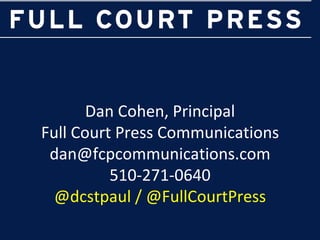
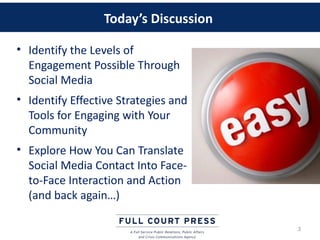
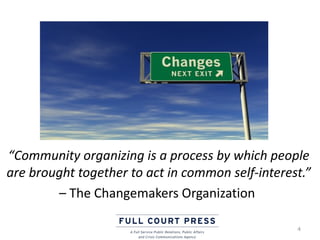
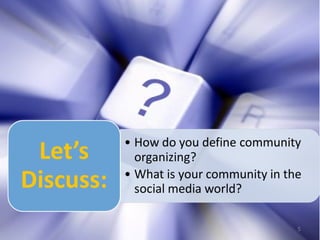
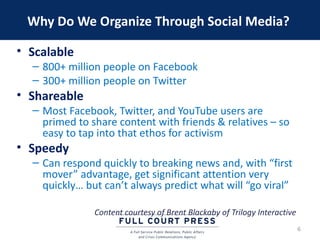

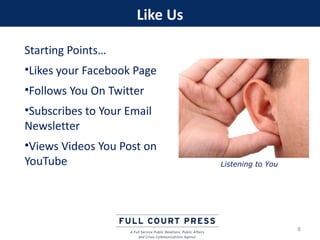

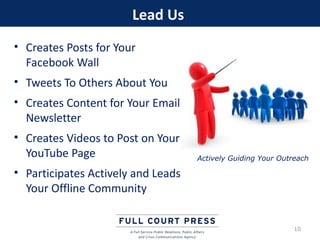

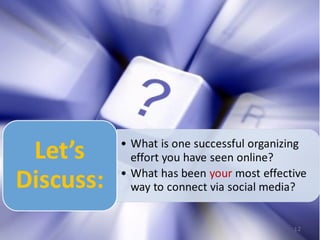
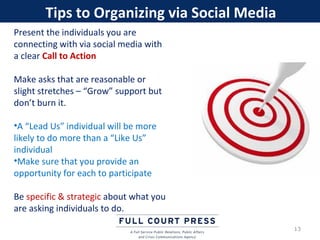
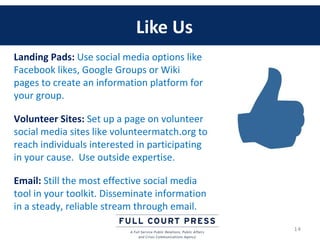
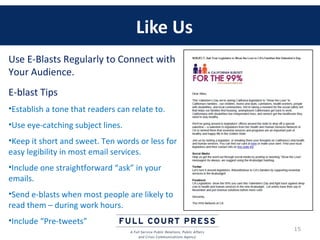
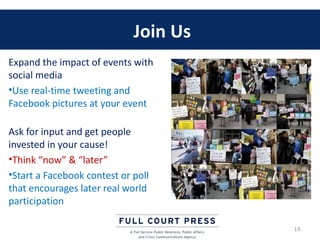
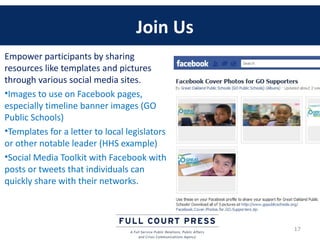
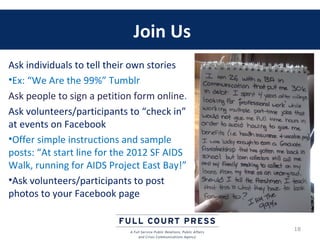

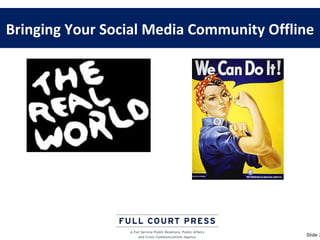



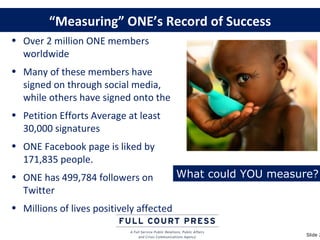
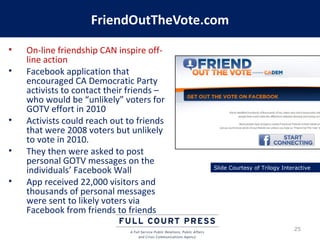
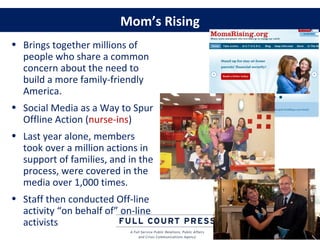


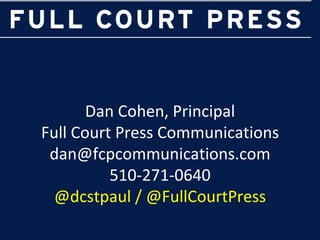
Ad
Recommended
Women's policy institute handouts for sharing
Women's policy institute handouts for sharingDan Cohen
╠²
messaging, advocacy, storytelling, bridging, testimonyStorytelling - Interview Worksheet
Storytelling - Interview WorksheetDan Cohen
╠²
This worksheet provides guidance for conducting an interview to craft someone else's story. It includes questions to ask the interview subject about what they are proudest of, who was involved in the event or experience, what happened, why it mattered, when it took place, details of what occurred, what challenges were overcome, larger lessons learned, and any remaining legacy. The goal is to gather comprehensive first-person details and perspectives to retell their story.UC Berkeley Center for Health Leaders - Intro to Social Media
UC Berkeley Center for Health Leaders - Intro to Social MediaDan Cohen
╠²
This document provides an overview of a social media 101 training session that introduces Facebook, LinkedIn, and Twitter. The training aims to help participants understand the purpose and functionality of various social media tools. It encourages participants to connect with the presenters on social media platforms and engage with at least one new activity. The training covers topics like customizing profiles and newsfeeds, building lists, using data to understand audiences, and linking accounts across platforms. The goal is to help participants feel comfortable starting to use social media.HELP - Emerging Leaders Program - Social Media Webinar
HELP - Emerging Leaders Program - Social Media WebinarDan Cohen
╠²
The document discusses the importance of social media for organizations and leaders, emphasizing strategies for effectively engaging with these platforms. It encourages participants to assess their comfort and readiness with new media, listen to their communities, and utilize various tools like Twitter and Facebook to enhance communication and outreach. Overall, it highlights actionable steps for creating a strong online presence and fostering connections within networks.Women's policy institute
Women's policy instituteDan Cohen
╠²
The document provides guidance on effective messaging and testimony for promoting policy goals. It discusses identifying key messages and stories, framing discussions positively, preparing fact sheets, and practicing question-and-answer sessions. Tips are given for public speaking, staying on message, telling impactful stories, and responding to different types of questions. The overall aim is to help participants communicate their policy expertise and goals in a clear, persuasive manner.Social media tribe building: CALPACT Jan 2012
Social media tribe building: CALPACT Jan 2012Dan Cohen
╠²
This document provides an overview of using new media tools to build communities and engage key audiences. It discusses developing a communications strategy, understanding your target audiences, selecting appropriate tools like Facebook, Twitter and YouTube, and measuring the impact of your efforts. Examples are given of how organizations have successfully used tools like Twitter to connect people with shared interests and build "tribes" of supporters. The document stresses starting with clear goals and testing different approaches.CALPACT - Engaging Target Audiences march 15 2012
CALPACT - Engaging Target Audiences march 15 2012Dan Cohen
╠²
The document provides guidance on using new media tools to educate the public and target audiences. It discusses planning communications strategies, identifying key audiences, and adjusting messaging for different audiences and media. Specific tools covered include social media platforms like Facebook, Twitter, Pinterest, Tumblr, and video sharing sites. The document also provides reality checks on reaching students and millennials with strategies like offering personal connections, soliciting user-generated content, and using mobile technologies.Bialik Ambassador Workshop
Bialik Ambassador WorkshopDan Cohen
╠²
The document provides guidance on becoming an effective ambassador and storyteller. It discusses the importance of listening to others, finding your unique voice, and using storytelling to share your message. Tips are given on framing issues, developing compelling stories, and using tools like video to share stories more widely. The goal is to help ambassadors spread the word about their organization and issues in an engaging way.ALIGN 2011 social media session
ALIGN 2011 social media sessionDan Cohen
╠²
This document discusses using social media and new media tools for organizations. It provides an overview of social media options like websites, blogs, Facebook, Twitter, YouTube and LinkedIn. It encourages organizations to think about their communications goals, audiences, and strategy before engaging with these tools. The document provides tips on getting started with social media, including listening first on Twitter, taking and sharing photos/videos, and building an online presence through a website and fan base on Facebook. It emphasizes the importance of being strategic and finding the right tools to fit an organization's goals.Marin Leadership Team 2011: Social Media for Everyone
Marin Leadership Team 2011: Social Media for EveryoneDan Cohen
╠²
This document discusses using social media to engage communities. It provides tips on assessing organizational readiness for social media, listening to audiences, telling stories through photos and videos, building websites and social media presences, and using tools like Facebook, Twitter and LinkedIn to connect with others. The goal is to start simple by listening first before engaging, and to use new media to better inform communities and strengthen networks.Alameda County Public Health - Social Media Convos
Alameda County Public Health - Social Media ConvosDan Cohen
╠²
This document provides questions to brainstorm goals and strategies for social media conversations. Part 1 focuses on determining organizational goals for social media use and measuring success. Part 2 involves building on these goals by identifying target audiences, desired actions, messaging, and representatives. Part 3 is developing a social media strategy by determining roles, prioritizing initial steps, securing support and resources, establishing metrics, and choosing appropriate tools. The overall document aims to guide a collaborative discussion around establishing a comprehensive yet practical social media approach.Alameda County Public Health Convo
Alameda County Public Health ConvoDan Cohen
╠²
The document provides an overview of using social media for organizational purposes. It discusses assessing organizational readiness, listening to audiences and peers, being strategic with goals and messaging, using tools like LinkedIn, Twitter, websites and Facebook to connect, share information and build an online presence and following. The document emphasizes starting small, listening before engaging, and seeing social media as a way to further organizational goals and connect with key audiences.Worksheets - Putting a positive face on public service
Worksheets - Putting a positive face on public serviceDan Cohen
╠²
This document provides guidance for becoming an ambassador and effective communicator for CEMA (the organization is not defined). It suggests identifying key allies and critics, understanding your audience and impact. It also includes questions to help craft a personal vision and story, identify target audiences, and develop a communications plan. Sample interview questions are provided to help craft another person's story about their work.Goyette FCP Cook - Session 4 - Case Study and next steps
Goyette FCP Cook - Session 4 - Case Study and next stepsDan Cohen
╠²
The document discusses a case study from Chico focusing on negotiation issues regarding public safety cuts and support for police and fire departments. It outlines a strategy for addressing these problems, emphasizing the importance of messaging, defining debates, and coordinating efforts within coalitions to drive the conversation effectively. Key steps include identifying desired discussions, understanding alliances, and maintaining clear communication and roles among coalition members.Goyette FCP Cook - Session on Officer to Officer Social Media Planning - pt o...
Goyette FCP Cook - Session on Officer to Officer Social Media Planning - pt o...Dan Cohen
╠²
The document discusses the importance of social media for establishing communication within an association and with the public, emphasizing effective message dissemination and member engagement. It highlights methods such as email drives and social media platforms to maintain consistent messaging and foster community involvement. Ultimately, the text advocates for utilizing social media to enhance visibility and public discourse around the association's initiatives.Goyette FCP Cook - Session 3 Storytelling Messaging
Goyette FCP Cook - Session 3 Storytelling MessagingDan Cohen
╠²
The document provides tips on effective storytelling and messaging. It discusses how storytelling can help humanize issues and make them more relatable through the use of anecdotes. Several steps for crafting a good story are outlined, including starting with a common assumption, introducing conflict, identifying heroes and villains, including memorable details, and showing a path to resolution. Effective framing and developing clear key messages are also addressed.Goyette FCP Cook session 2 - Rapid Fire Comm Planning
Goyette FCP Cook session 2 - Rapid Fire Comm PlanningDan Cohen
╠²
The document discusses communications planning and provides guidance on answering "The Big 5 Questions" to develop an effective plan. The questions address determining clear and measurable objectives, identifying key decision-makers and influencers, assessing organizational strengths and weaknesses, defining target audiences and their needs, and selecting appropriate tactics and timelines. Chevron's campaign to promote oil use while addressing climate change is discussed as an example of targeting the open middle audience.Goyette FCP Cook - Session 1 - Understanding Audiences
Goyette FCP Cook - Session 1 - Understanding AudiencesDan Cohen
╠²
The document provides guidance on strategic communications and the role of associations in a post-Wisconsin political environment. It recommends developing a communications plan that goes beyond traditional media to reach target audiences, prioritizing dissemination over media relations. Associations are advised to determine their strengths and priorities, find consensus to avoid division, and focus initially on internal communications to solidify their position.Goyette FCP Cook - planning worksheets
Goyette FCP Cook - planning worksheetsDan Cohen
╠²
The document provides guidance and questions for an individual to reflect on their role as an ambassador for their organization. It prompts the individual to identify their most important allies and toughest opponents. It also encourages developing a vision statement, identifying target audiences to communicate with, and sharing past successes. The individual is asked to consider their organization's best assets and weaknesses as well as strengths in engaging with local leadership. They are provided with questions to help in interviewing another officer to craft their story in bringing positive change.HHSNetworkCA --- Twitter for US
HHSNetworkCA --- Twitter for USDan Cohen
╠²
The document discusses using Twitter to connect with key audiences and make social change. It provides tips on listening to others on Twitter, taking the plunge to start tweeting, and tools like TweetDeck and Hootsuite that can help manage tweets. The goal is to help members of the HHS Network CA learn strategies for effectively using Twitter to advocate, share information, and collaborate.Social media for health advocacy. UC Berkeley Ctr Health Ldrshp
Social media for health advocacy. UC Berkeley Ctr Health LdrshpDan Cohen
╠²
This document summarizes a presentation on using social media tools for advocacy and communication. It discusses how to use LinkedIn to build professional networks, Twitter to share short updates and engage in conversations using hashtags, YouTube and Flickr to share videos and photos, and blogs and websites to establish an online presence. The presentation emphasizes listening first before broadcasting, telling your own story, building audiences, and tracking metrics to measure success. Attendees are encouraged to start using one new tool and to find ways their organizations can better connect with key audiences online.Mills MBA - PR 101 for Artists
Mills MBA - PR 101 for ArtistsDan Cohen
╠²
The document provides tips and strategies for public relations, event planning, communications, and media relations. It discusses developing key messages and stories, understanding audiences, framing issues, responding to questions from reporters, and tips for effective interviews. The overall focus is on planning communications to achieve organizational goals and priorities through various media and dissemination strategies.Fighting Mental Health Stigma through social media
Fighting Mental Health Stigma through social mediaDan Cohen
╠²
This document provides guidance on using social media for organizations. It recommends starting with LinkedIn to build connections, then using Twitter to listen to conversations and share short updates. Taking photos or videos and sharing them on Flickr or YouTube is also suggested. The document advises creating a website to host content and track engagement. Using Facebook to connect with supporters, ask their opinions, and add applications is presented as a way to build a following. Throughout, the document emphasizes listening before broadcasting and starting small with one new tool.Comm. Foundation of San Benito - Quick Steps to comm planning
Comm. Foundation of San Benito - Quick Steps to comm planningDan Cohen
╠²
The document provides guidance on developing an effective communications plan by focusing on key questions:
1) Define clear objectives and how success will be measured.
2) Identify who the key decision-makers are and who influences them.
3) Understand your organizational strengths and weaknesses.
4) Determine your target audiences and what messages will resonate with them.
5) Select appropriate tactics and set a timeline to achieve your objectives.HELP - Planning guide
HELP - Planning guideDan Cohen
╠²
The document provides guidance for brainstorming and developing a social media plan. It prompts visualization of current social media efforts and gathering feedback. Participants are asked to define goals and key audiences, consider messaging and platforms, and discuss implementation including resources, measurement, and gaining support. The goal is to collaboratively outline an actionable social media strategy.Storytelling - Its not just the why, but its the how
Storytelling - Its not just the why, but its the howDan Cohen
╠²
The document provides guidance on effective storytelling and communication strategies. It discusses framing issues, sharing stories on social media, developing a story bank, and telling stories to further organizational goals. Specific tips include starting with a common assumption, introducing conflict, including memorable details, and showing a path to resolution.S4F03 Col11 Conversion of Accounting to SAP S/4HANA
S4F03 Col11 Conversion of Accounting to SAP S/4HANALibreria ERP
╠²
This ebook provides an in-depth overview of the conversion process involved in transitioning to SAP S/4HANA, focusing specifically on accounting systems. It explains the various steps required for a successful conversion project, from analyzing the starting point of a system to implementing necessary configurations for General Ledger and Asset Accounting. It includes detailed guidance on managing migration starting from Classic G/L, preparing the system before conversion, and interpreting post-migration results. Special attention is given to the near zero-downtime scenario and the changes that occur immediately following migration. This resource is essential for professionals involved in SAP S/4HANA migrations who need a thorough understanding of the process and configuration requirements.Ihor Pavlenko: ąŻą┐čĆą░ą▓ą╗č¢ąĮąĮčÅ čĆąĖąĘąĖą║ą░ą╝ąĖ ąĘą░ ą┤ąŠą┐ąŠą╝ąŠą│ąŠčÄ AI (UA)
Ihor Pavlenko: ąŻą┐čĆą░ą▓ą╗č¢ąĮąĮčÅ čĆąĖąĘąĖą║ą░ą╝ąĖ ąĘą░ ą┤ąŠą┐ąŠą╝ąŠą│ąŠčÄ AI (UA)Lviv Startup Club
╠²
Ihor Pavlenko: ąŻą┐čĆą░ą▓ą╗č¢ąĮąĮčÅ čĆąĖąĘąĖą║ą░ą╝ąĖ ąĘą░ ą┤ąŠą┐ąŠą╝ąŠą│ąŠčÄ AI (UA)
LemBS AI PM School 2025
Website ŌĆō https://lembs.com/aipmschool
Youtube ŌĆō https://www.youtube.com/startuplviv
FB ŌĆō https://www.facebook.com/pmdayconferenceMore Related Content
More from Dan Cohen (20)
Bialik Ambassador Workshop
Bialik Ambassador WorkshopDan Cohen
╠²
The document provides guidance on becoming an effective ambassador and storyteller. It discusses the importance of listening to others, finding your unique voice, and using storytelling to share your message. Tips are given on framing issues, developing compelling stories, and using tools like video to share stories more widely. The goal is to help ambassadors spread the word about their organization and issues in an engaging way.ALIGN 2011 social media session
ALIGN 2011 social media sessionDan Cohen
╠²
This document discusses using social media and new media tools for organizations. It provides an overview of social media options like websites, blogs, Facebook, Twitter, YouTube and LinkedIn. It encourages organizations to think about their communications goals, audiences, and strategy before engaging with these tools. The document provides tips on getting started with social media, including listening first on Twitter, taking and sharing photos/videos, and building an online presence through a website and fan base on Facebook. It emphasizes the importance of being strategic and finding the right tools to fit an organization's goals.Marin Leadership Team 2011: Social Media for Everyone
Marin Leadership Team 2011: Social Media for EveryoneDan Cohen
╠²
This document discusses using social media to engage communities. It provides tips on assessing organizational readiness for social media, listening to audiences, telling stories through photos and videos, building websites and social media presences, and using tools like Facebook, Twitter and LinkedIn to connect with others. The goal is to start simple by listening first before engaging, and to use new media to better inform communities and strengthen networks.Alameda County Public Health - Social Media Convos
Alameda County Public Health - Social Media ConvosDan Cohen
╠²
This document provides questions to brainstorm goals and strategies for social media conversations. Part 1 focuses on determining organizational goals for social media use and measuring success. Part 2 involves building on these goals by identifying target audiences, desired actions, messaging, and representatives. Part 3 is developing a social media strategy by determining roles, prioritizing initial steps, securing support and resources, establishing metrics, and choosing appropriate tools. The overall document aims to guide a collaborative discussion around establishing a comprehensive yet practical social media approach.Alameda County Public Health Convo
Alameda County Public Health ConvoDan Cohen
╠²
The document provides an overview of using social media for organizational purposes. It discusses assessing organizational readiness, listening to audiences and peers, being strategic with goals and messaging, using tools like LinkedIn, Twitter, websites and Facebook to connect, share information and build an online presence and following. The document emphasizes starting small, listening before engaging, and seeing social media as a way to further organizational goals and connect with key audiences.Worksheets - Putting a positive face on public service
Worksheets - Putting a positive face on public serviceDan Cohen
╠²
This document provides guidance for becoming an ambassador and effective communicator for CEMA (the organization is not defined). It suggests identifying key allies and critics, understanding your audience and impact. It also includes questions to help craft a personal vision and story, identify target audiences, and develop a communications plan. Sample interview questions are provided to help craft another person's story about their work.Goyette FCP Cook - Session 4 - Case Study and next steps
Goyette FCP Cook - Session 4 - Case Study and next stepsDan Cohen
╠²
The document discusses a case study from Chico focusing on negotiation issues regarding public safety cuts and support for police and fire departments. It outlines a strategy for addressing these problems, emphasizing the importance of messaging, defining debates, and coordinating efforts within coalitions to drive the conversation effectively. Key steps include identifying desired discussions, understanding alliances, and maintaining clear communication and roles among coalition members.Goyette FCP Cook - Session on Officer to Officer Social Media Planning - pt o...
Goyette FCP Cook - Session on Officer to Officer Social Media Planning - pt o...Dan Cohen
╠²
The document discusses the importance of social media for establishing communication within an association and with the public, emphasizing effective message dissemination and member engagement. It highlights methods such as email drives and social media platforms to maintain consistent messaging and foster community involvement. Ultimately, the text advocates for utilizing social media to enhance visibility and public discourse around the association's initiatives.Goyette FCP Cook - Session 3 Storytelling Messaging
Goyette FCP Cook - Session 3 Storytelling MessagingDan Cohen
╠²
The document provides tips on effective storytelling and messaging. It discusses how storytelling can help humanize issues and make them more relatable through the use of anecdotes. Several steps for crafting a good story are outlined, including starting with a common assumption, introducing conflict, identifying heroes and villains, including memorable details, and showing a path to resolution. Effective framing and developing clear key messages are also addressed.Goyette FCP Cook session 2 - Rapid Fire Comm Planning
Goyette FCP Cook session 2 - Rapid Fire Comm PlanningDan Cohen
╠²
The document discusses communications planning and provides guidance on answering "The Big 5 Questions" to develop an effective plan. The questions address determining clear and measurable objectives, identifying key decision-makers and influencers, assessing organizational strengths and weaknesses, defining target audiences and their needs, and selecting appropriate tactics and timelines. Chevron's campaign to promote oil use while addressing climate change is discussed as an example of targeting the open middle audience.Goyette FCP Cook - Session 1 - Understanding Audiences
Goyette FCP Cook - Session 1 - Understanding AudiencesDan Cohen
╠²
The document provides guidance on strategic communications and the role of associations in a post-Wisconsin political environment. It recommends developing a communications plan that goes beyond traditional media to reach target audiences, prioritizing dissemination over media relations. Associations are advised to determine their strengths and priorities, find consensus to avoid division, and focus initially on internal communications to solidify their position.Goyette FCP Cook - planning worksheets
Goyette FCP Cook - planning worksheetsDan Cohen
╠²
The document provides guidance and questions for an individual to reflect on their role as an ambassador for their organization. It prompts the individual to identify their most important allies and toughest opponents. It also encourages developing a vision statement, identifying target audiences to communicate with, and sharing past successes. The individual is asked to consider their organization's best assets and weaknesses as well as strengths in engaging with local leadership. They are provided with questions to help in interviewing another officer to craft their story in bringing positive change.HHSNetworkCA --- Twitter for US
HHSNetworkCA --- Twitter for USDan Cohen
╠²
The document discusses using Twitter to connect with key audiences and make social change. It provides tips on listening to others on Twitter, taking the plunge to start tweeting, and tools like TweetDeck and Hootsuite that can help manage tweets. The goal is to help members of the HHS Network CA learn strategies for effectively using Twitter to advocate, share information, and collaborate.Social media for health advocacy. UC Berkeley Ctr Health Ldrshp
Social media for health advocacy. UC Berkeley Ctr Health LdrshpDan Cohen
╠²
This document summarizes a presentation on using social media tools for advocacy and communication. It discusses how to use LinkedIn to build professional networks, Twitter to share short updates and engage in conversations using hashtags, YouTube and Flickr to share videos and photos, and blogs and websites to establish an online presence. The presentation emphasizes listening first before broadcasting, telling your own story, building audiences, and tracking metrics to measure success. Attendees are encouraged to start using one new tool and to find ways their organizations can better connect with key audiences online.Mills MBA - PR 101 for Artists
Mills MBA - PR 101 for ArtistsDan Cohen
╠²
The document provides tips and strategies for public relations, event planning, communications, and media relations. It discusses developing key messages and stories, understanding audiences, framing issues, responding to questions from reporters, and tips for effective interviews. The overall focus is on planning communications to achieve organizational goals and priorities through various media and dissemination strategies.Fighting Mental Health Stigma through social media
Fighting Mental Health Stigma through social mediaDan Cohen
╠²
This document provides guidance on using social media for organizations. It recommends starting with LinkedIn to build connections, then using Twitter to listen to conversations and share short updates. Taking photos or videos and sharing them on Flickr or YouTube is also suggested. The document advises creating a website to host content and track engagement. Using Facebook to connect with supporters, ask their opinions, and add applications is presented as a way to build a following. Throughout, the document emphasizes listening before broadcasting and starting small with one new tool.Comm. Foundation of San Benito - Quick Steps to comm planning
Comm. Foundation of San Benito - Quick Steps to comm planningDan Cohen
╠²
The document provides guidance on developing an effective communications plan by focusing on key questions:
1) Define clear objectives and how success will be measured.
2) Identify who the key decision-makers are and who influences them.
3) Understand your organizational strengths and weaknesses.
4) Determine your target audiences and what messages will resonate with them.
5) Select appropriate tactics and set a timeline to achieve your objectives.HELP - Planning guide
HELP - Planning guideDan Cohen
╠²
The document provides guidance for brainstorming and developing a social media plan. It prompts visualization of current social media efforts and gathering feedback. Participants are asked to define goals and key audiences, consider messaging and platforms, and discuss implementation including resources, measurement, and gaining support. The goal is to collaboratively outline an actionable social media strategy.Storytelling - Its not just the why, but its the how
Storytelling - Its not just the why, but its the howDan Cohen
╠²
The document provides guidance on effective storytelling and communication strategies. It discusses framing issues, sharing stories on social media, developing a story bank, and telling stories to further organizational goals. Specific tips include starting with a common assumption, introducing conflict, including memorable details, and showing a path to resolution.Recently uploaded (20)
S4F03 Col11 Conversion of Accounting to SAP S/4HANA
S4F03 Col11 Conversion of Accounting to SAP S/4HANALibreria ERP
╠²
This ebook provides an in-depth overview of the conversion process involved in transitioning to SAP S/4HANA, focusing specifically on accounting systems. It explains the various steps required for a successful conversion project, from analyzing the starting point of a system to implementing necessary configurations for General Ledger and Asset Accounting. It includes detailed guidance on managing migration starting from Classic G/L, preparing the system before conversion, and interpreting post-migration results. Special attention is given to the near zero-downtime scenario and the changes that occur immediately following migration. This resource is essential for professionals involved in SAP S/4HANA migrations who need a thorough understanding of the process and configuration requirements.Ihor Pavlenko: ąŻą┐čĆą░ą▓ą╗č¢ąĮąĮčÅ čĆąĖąĘąĖą║ą░ą╝ąĖ ąĘą░ ą┤ąŠą┐ąŠą╝ąŠą│ąŠčÄ AI (UA)
Ihor Pavlenko: ąŻą┐čĆą░ą▓ą╗č¢ąĮąĮčÅ čĆąĖąĘąĖą║ą░ą╝ąĖ ąĘą░ ą┤ąŠą┐ąŠą╝ąŠą│ąŠčÄ AI (UA)Lviv Startup Club
╠²
Ihor Pavlenko: ąŻą┐čĆą░ą▓ą╗č¢ąĮąĮčÅ čĆąĖąĘąĖą║ą░ą╝ąĖ ąĘą░ ą┤ąŠą┐ąŠą╝ąŠą│ąŠčÄ AI (UA)
LemBS AI PM School 2025
Website ŌĆō https://lembs.com/aipmschool
Youtube ŌĆō https://www.youtube.com/startuplviv
FB ŌĆō https://www.facebook.com/pmdayconferenceWebinar: Why Odoo is a game-changer for Service Companies
Webinar: Why Odoo is a game-changer for Service Companiesdear digital
╠²
Watch the webinar: https://youtu.be/49xUiOHJwa4
Running a service business? Then you know how messy operations can get.
YouŌĆÖre not selling products. YouŌĆÖre selling time, expertise, and client satisfaction. That means your tools need to handle projects, people, planning, and billing - all in one place.
ThatŌĆÖs exactly where Odoo shines. Unlike traditional ERP systems, Odoo is built to support the unique workflows of service companies. From managing projects and tracking time to invoicing, signing contracts, and handling support tickets: Odoo brings everything together. No more jumping between a plethora of spreadsheets, tools, and inboxes.
With over 45 modules, Odoo grows with your business. Need CRM today, Helpdesk tomorrow? No worries, itŌĆÖs all connected. Plus, itŌĆÖs fully customizable to match the way your company works.
Wondering if itŌĆÖs a fit?
Join our 1-hour webinar where our Odoo expert Julien will walk you through the power of Odoo for service companies, complete with real-life examples from companies like yours!
What youŌĆÖll learn:
Ō£ģ How Odoo streamlines the entire service lifecycle
Ō£ģ Key modules for service businesses: Project, Timesheets, CRM, Invoicing & more
Ō£ģ How reporting works within Odoo
Ō£ģ What makes Odoo different from other ERP systems
Ō£ģ When Odoo is a fit for your company (and when it's not)
Ō£ģ A demo where we guide you through the possibilities step-by-step
Ak─Źn├Ł pl├Īn pro chemick├Į pr┼»mysl - Ivan Sou─Źek
Ak─Źn├Ł pl├Īn pro chemick├Į pr┼»mysl - Ivan Sou─Źekpavelborek
╠²
Kulat├Į st┼»l: CLEAN INDUSTRIAL DEAL ŌĆō BUDOUCNOST ─īESK├ē CHEMIE A OCEL├ü┼śSTV├Ź se uskute─Źnil 18.6.2025 v s├Łdle HK ─īRPower of the Many: Digital Energy Masterclass
Power of the Many: Digital Energy Masterclassmariana491193
╠²
Masterclass on digitalisation of Energy SystemsNoah Loul Shares 5 Key Impacts of AI Agents on the Sales Industry.pdf
Noah Loul Shares 5 Key Impacts of AI Agents on the Sales Industry.pdfNoah Loul
╠²
Noah Loul is the CEO of AI Agents by B2B Rocket, a company dedicated to transforming how sales teams operate using AI. With a clear and practical approach, Noah is creating tools that help businesses respond quickly, qualify leads more effectively, and close more deals. He believes technology should support people, not replace them, and his work helps sales teams accomplish more with less effort. Noah Loul shares five straightforward ways AI agents are changing the way sales teams work and helping businesses boost their sales.Enterprise Architecture Professional Journal Vol IX June 2025.pdf
Enterprise Architecture Professional Journal Vol IX June 2025.pdfDarryl_Carr
╠²
Volume IX of the Enterprise Architecture Professional Journal on EAPJ.org, released June 2025.
It features:
- A welcome from the EAPJ Editor, Darryl Carr.
- A special note from the EAPJ Founder, Steve Else.
- An article from Alexandre Luis Prim and Tiago Lemos de Oliveira featuring a case study of value creation from Enterprise Architecture.
We hope you enjoy the latest publication, with insights into the world of Enterprise Architecture.What Drives Collectors in Sports and Beyond, and How Mantel is Bringing Them ...
What Drives Collectors in Sports and Beyond, and How Mantel is Bringing Them ...Neil Horowitz
╠²
On episode 2947of the Digital and Social Media Sports Podcast, Neil chatted with Evan Parker, CEO of Mantel.
What follows is a collection of snippets from the podcast. To hear the full interview and more, check out the podcast on all podcast platforms and at www.dsmsports.net.Axcess Instruments Pitch Deck - Newport Beach Investor Conference 2025
Axcess Instruments Pitch Deck - Newport Beach Investor Conference 2025Hector Del Castillo, CPM, CPMM
╠²
Axcess Instruments Pitch Deck for Newport Beach Investor Conference 2025BOURNS POTENTIOMETER Provide You Precision
BOURNS POTENTIOMETER Provide You Precisionsmidmart
╠²
Bourns potentiometers are high-quality variable resistors designed for precision control in a wide range of electronic applications. Known for their durability, accuracy, and reliability, Bourns potentiometers are ideal for adjusting signal levels, tuning circuits, or setting reference voltages in industrial, automotive, and consumer electronics.
Available in rotary and slide variants, these components offer excellent repeatability, smooth operation, and long mechanical life, making them a trusted choice for engineers and designers worldwide.
smidmart industrial Automation Ones Stop Solution
smidmart industrial Automation Ones Stop Solutionsmidmart
╠²
Smidmart is an industrial automation products one stop solutions where you got all materials you want from control panel cutomization to checkweigher parts your one stop solution is smidart . we are avialble on https://www.smidmart.com/The Strategic Landscape of EssarŌĆÖs CSR Initiatives in 2024
The Strategic Landscape of EssarŌĆÖs CSR Initiatives in 2024essarupdate
╠²
The Essar Group, a diversified conglomerate with interests spanning energy, infrastructure, metals & mining, ports, steel and construction, technology and retail, has long been a leader in corporate philanthropy. The companyŌĆÖs Corporate Social Responsibility (CSR) arm ŌĆö Essar Foundation is an independent identity, working to strengthen the groupŌĆÖs vision for an equitable and sustainable world. Over the last 50 years, Essar Foundation has worked closely with communities at the grassroots to address local social, economic, and environmental issues.IT Companies in Magarpatta: A Thriving Hub of Technology and Innovation
IT Companies in Magarpatta: A Thriving Hub of Technology and Innovationprernarathi90
╠²
IT Firms in Magarpatta have transformed the region into one of PuneŌĆÖs most vibrant and sought-after technology destinations. Located in Hadapsar, Magarpatta City is a privately managed, self-sustained township that blends residential, commercial, and IT infrastructure with green and eco-friendly planning. The presence of leading software companies, excellent connectivity, and world-class amenities make it a hotspot for IT professionals and businesses alike.
Paul Turovsky - A Key Contributor
Paul Turovsky - A Key ContributorPaul Turovsky
╠²
Paul Turovsky is a manager for Foursquare Realty Investments. He graduated from Ave Maria School of Law in 2013 and received his undergraduate degree from Baruch College. Mr. Turovsky has founded multiple real estate firms to serve various functions. Noah Loul Shares 5 Key Impacts of AI Agents on the Sales Industry
Noah Loul Shares 5 Key Impacts of AI Agents on the Sales IndustryNoah Loul
╠²
Noah Loul is the CEO of AI Agents by B2B Rocket, a company dedicated to transforming how sales teams operate using AI. With a clear and practical approach, Noah Loul is creating tools that help businesses respond quickly, qualify leads more effectively, and close more deals. He believes technology should support people, not replace them, and his work helps sales teams accomplish more with less effort. Noah Loul shares five straightforward ways AI agents are changing the way sales teams work and helping businesses boost their sales.Vaden Consultancy: Transforming Businesses with Integrated HR, IT, and Cloud ...
Vaden Consultancy: Transforming Businesses with Integrated HR, IT, and Cloud ...Vaden Consultancy
╠²
At Vaden Consultancy, we specialize in aligning talent, technology, and infrastructure to power business transformation. Our integrated service model brings together end-to-end HR consultancy, custom software development, and cloud infrastructure management ŌĆö enabling organizations to scale efficiently, adapt faster, and stay future-ready.
From sourcing top-tier talent and streamlining recruitment through RPO, to building enterprise-grade applications and deploying Microsoft 365, Azure, and Power Platform solutions ŌĆö we deliver a seamless experience under one roof. With expert support and strategic insight, we help businesses enhance productivity, reduce operational costs, and drive innovation at every level.
Vaden Consultancy is not just a service provider ŌĆö we are your strategic partner for growth in todayŌĆÖs digital-first economy. Improving Sales Forecasting in Volatile B2B Capital Equipment Markets - Dave ...
Improving Sales Forecasting in Volatile B2B Capital Equipment Markets - Dave ...Dave Litwiller
╠²
How to reestablish better sales forecasting, suitable to more volatile economic conditions. The case in point is B2B capital equipment industries, but the lessons extend well to other capital and large financial commitment sales, including SaaS and professional services, not just physical technologies.Ihor Pavlenko: ąŻą┐čĆą░ą▓ą╗č¢ąĮąĮčÅ čĆąĖąĘąĖą║ą░ą╝ąĖ ąĘą░ ą┤ąŠą┐ąŠą╝ąŠą│ąŠčÄ AI (UA)
Ihor Pavlenko: ąŻą┐čĆą░ą▓ą╗č¢ąĮąĮčÅ čĆąĖąĘąĖą║ą░ą╝ąĖ ąĘą░ ą┤ąŠą┐ąŠą╝ąŠą│ąŠčÄ AI (UA)Lviv Startup Club
╠²
Axcess Instruments Pitch Deck - Newport Beach Investor Conference 2025
Axcess Instruments Pitch Deck - Newport Beach Investor Conference 2025Hector Del Castillo, CPM, CPMM
╠²
Ad
